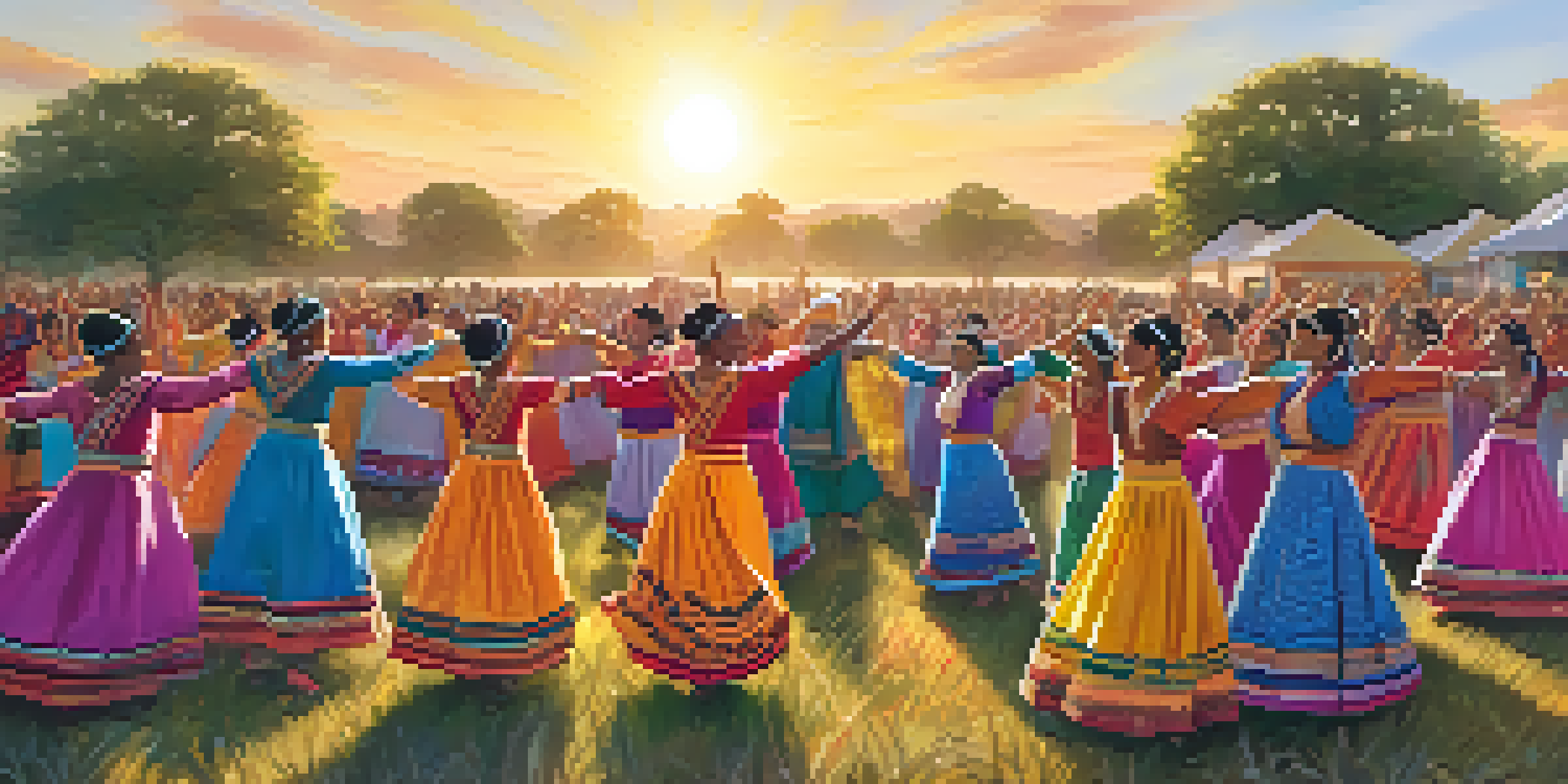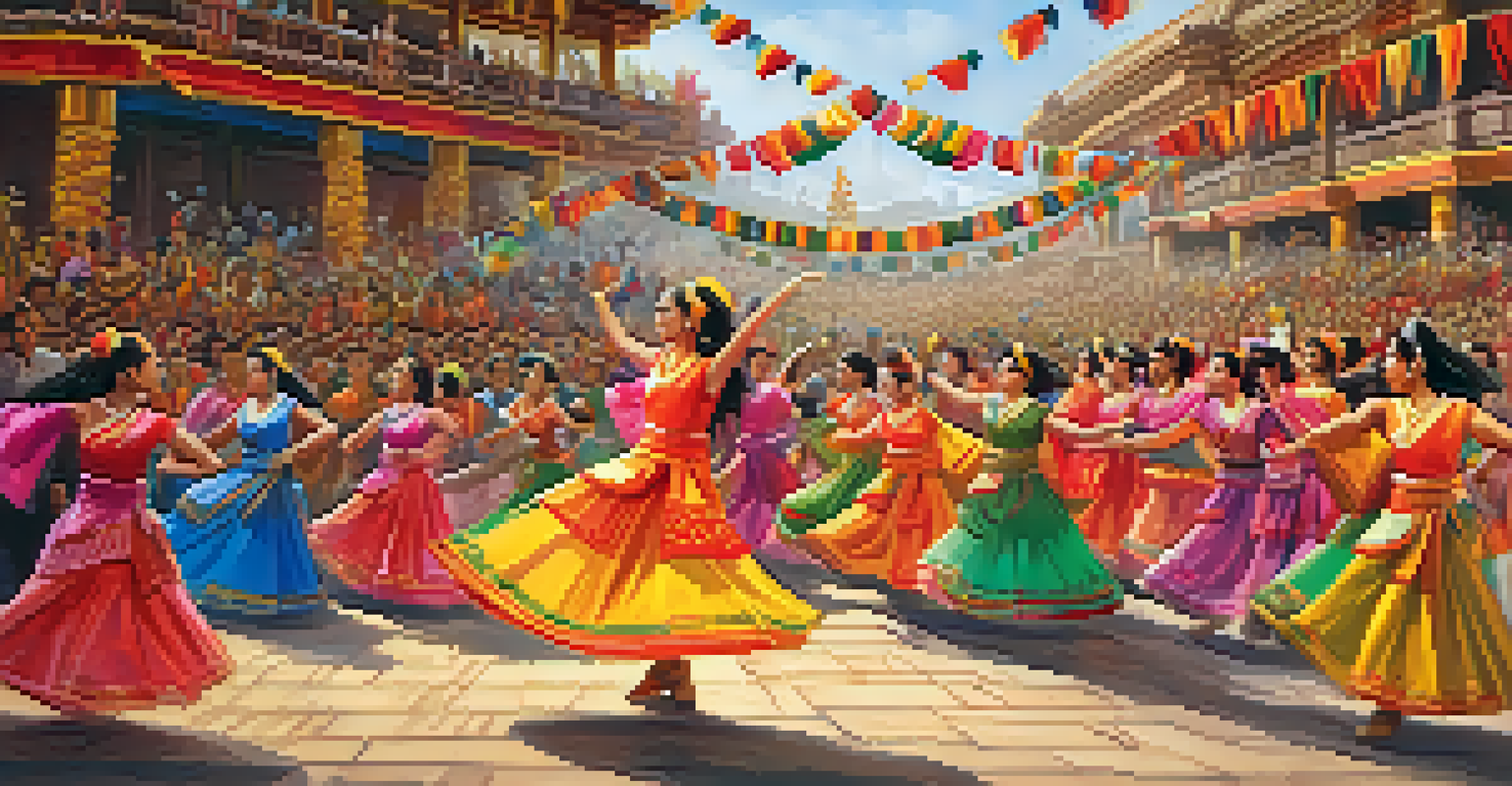Dance Rituals: Connecting Communities Through Shared Movements

Understanding Dance Rituals and Their Significance
Dance rituals are more than just movements; they are a profound way for communities to express their identities and values. Often tied to cultural traditions, these rituals weave together history, spirituality, and social connection. By participating in these dances, individuals feel a sense of belonging and unity with others who share similar backgrounds.
Dance is the hidden language of the soul.
For instance, in many Indigenous cultures, dance rituals are integral to ceremonies that celebrate life events such as harvests or rites of passage. These dances connect participants not only to their ancestors but also to the larger community, reinforcing shared beliefs and experiences. Through this connection, dance becomes a living expression of cultural heritage.
Ultimately, understanding dance rituals requires recognizing their role as a collective experience. They invite everyone to join in, regardless of skill level, fostering inclusivity and cooperation. This shared experience creates stronger community bonds, making dance an essential element of cultural continuity.
The Role of Dance in Celebrating Identity
Dance serves as a powerful tool for expressing cultural identity. Through specific styles, movements, and music, communities can share their unique stories and traditions. For example, the vibrant rhythms of a samba dance can evoke the spirit of Brazilian Carnival, showcasing the joy and resilience of Brazilian culture.

When individuals participate in these dances, they embody their heritage, allowing them to express pride in their identity. This celebration can be particularly poignant during community gatherings or festivals, where dance becomes a focal point for collective expression. It’s a reminder of who they are and where they come from.
Dance Rituals Foster Community Bonds
Through shared experiences in dance, individuals build connections that strengthen the fabric of their communities.
Moreover, these dance forms evolve over time, often blending with new influences while still honoring traditional roots. This adaptability ensures that cultural identity remains dynamic and relevant, engaging younger generations and inviting them to participate in their cultural narrative.
Building Social Cohesion Through Dance
Dance rituals foster social cohesion by bringing people together in a shared experience. Whether it's a local festival or a spontaneous gathering, dance creates a space where community members can interact and connect. For instance, circle dances encourage participants to hold hands and move as one, symbolizing unity and cooperation.
Dancing is like dreaming with your feet.
In many communities, these rituals often transcend age, gender, and social barriers, allowing for intergenerational bonding and mutual respect. When people dance together, they break down walls and build friendships, creating a supportive network that strengthens community ties. This sense of togetherness can be especially vital in times of challenge or change.
Additionally, these shared experiences can lead to collaborative efforts beyond the dance floor. Participants may band together to address local issues, organize events, or support one another in various aspects of life. Hence, dance rituals contribute to a vibrant, interconnected community fabric.
Dance as a Form of Healing and Expression
Dance rituals can also serve as a powerful form of healing and emotional expression. In many cultures, movement is used to process grief, celebrate milestones, or mark significant life changes. Through dance, individuals can release pent-up emotions and find solace in shared experiences.
For example, in some African communities, dance is an essential part of mourning rituals, allowing community members to come together in support of those grieving. Such practices not only honor the deceased but also strengthen social bonds among the living, reminding participants that they are not alone in their sorrow.
Cultural Identity Expressed Through Dance
Dance serves as a powerful medium for communities to convey their unique identities, stories, and traditions.
Moreover, dance can be a means of empowering individuals to express their identities and experiences. By allowing people to share their stories through movement, communities create spaces for understanding and empathy, fostering a culture of support and acceptance.
Cultural Exchange and Fusion Through Dance
Dance rituals often serve as platforms for cultural exchange, where different communities come together to share their traditions. This interaction can lead to the fusion of styles, creating new forms of dance that reflect a blend of cultural influences. For example, the emergence of hip-hop dance has roots in various cultures, showcasing how dance evolves through collaboration.
Such exchanges can enhance mutual respect and appreciation, breaking down stereotypes and fostering a sense of global community. When dancers from diverse backgrounds collaborate, they not only share their techniques but also their stories, enriching the collective experience.
This cultural fusion can also spark innovation, inspiring new generations to explore and redefine their identities through dance. By embracing diversity in movement, communities celebrate their uniqueness while also recognizing the interconnectedness of their experiences.
Preserving Traditions in a Modern World
In an increasingly fast-paced world, preserving traditional dance rituals can be challenging. However, many communities are finding creative ways to keep these practices alive. By integrating technology and social media, dancers can share their traditions with a broader audience, ensuring they remain relevant and accessible.
Workshops, online classes, and cultural festivals are some ways communities are revitalizing interest in their dance rituals. These initiatives not only attract younger participants but also educate outsiders about the significance of these dances. As a result, traditional movements find new life, adapting to contemporary contexts while retaining their core meaning.
Preserving Traditions Amid Change
Communities are creatively adapting traditional dance rituals to keep them relevant and engaging for future generations.
Moreover, this preservation effort can lead to renewed pride in cultural heritage. By actively engaging in dance rituals, communities reinforce their identity and pass it on to future generations, ensuring that these traditions continue to thrive.
The Future of Dance Rituals: Innovation and Continuity
As we look to the future, the role of dance rituals in connecting communities will likely continue to evolve. New technologies, social movements, and global interactions will shape how dance is practiced and perceived. However, the core purpose of bringing people together and fostering connection will remain unchanged.
Innovative choreographers and community leaders are already experimenting with new forms of dance that reflect contemporary issues and diverse experiences. By blending traditional elements with modern styles, they create fresh narratives that resonate with today's audiences, ensuring that the spirit of the ritual endures.

Ultimately, the future of dance rituals lies in their ability to adapt while holding onto their essential values of unity, expression, and cultural celebration. As communities navigate an ever-changing world, these shared movements will continue to be a vital thread in the tapestry of human connection.